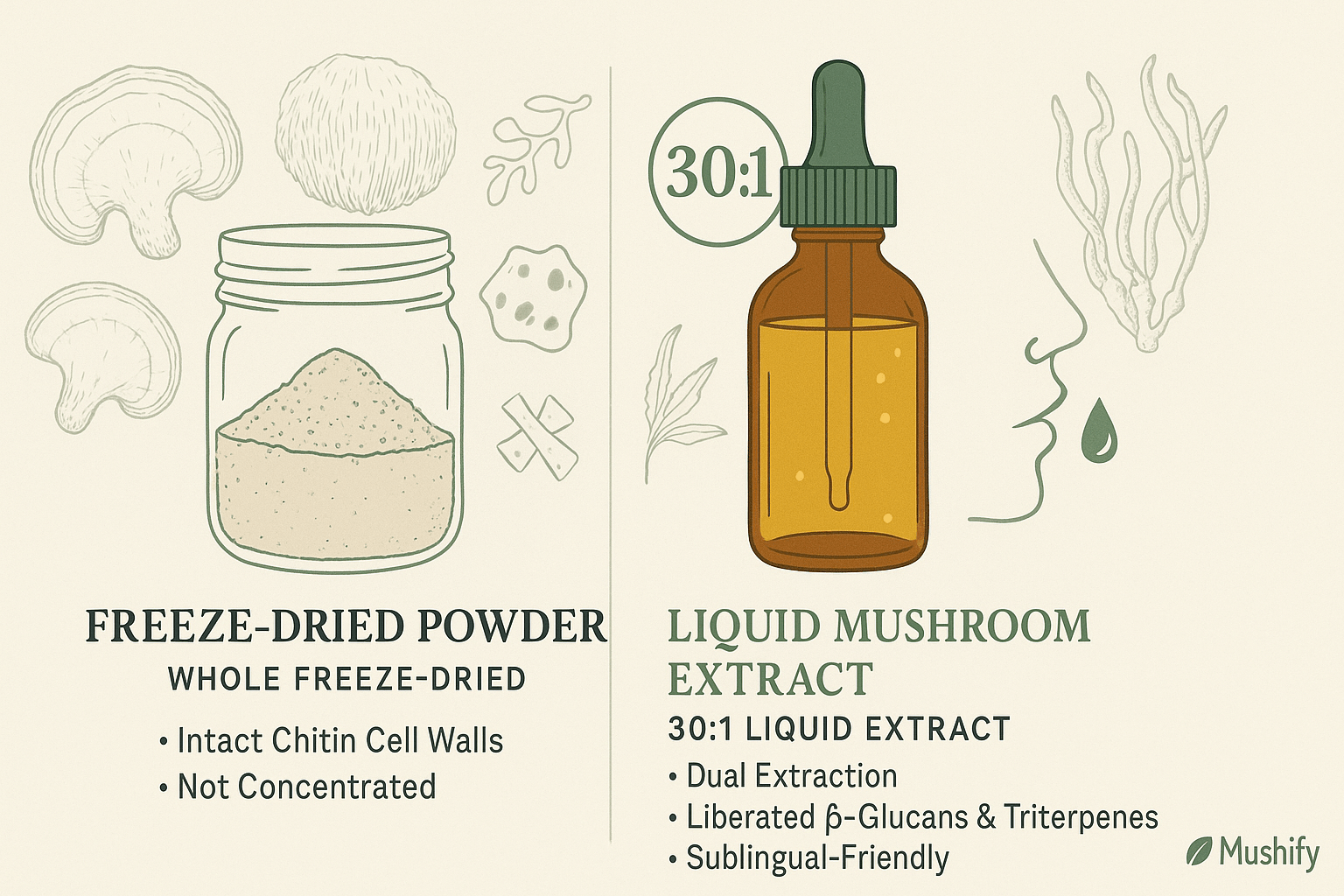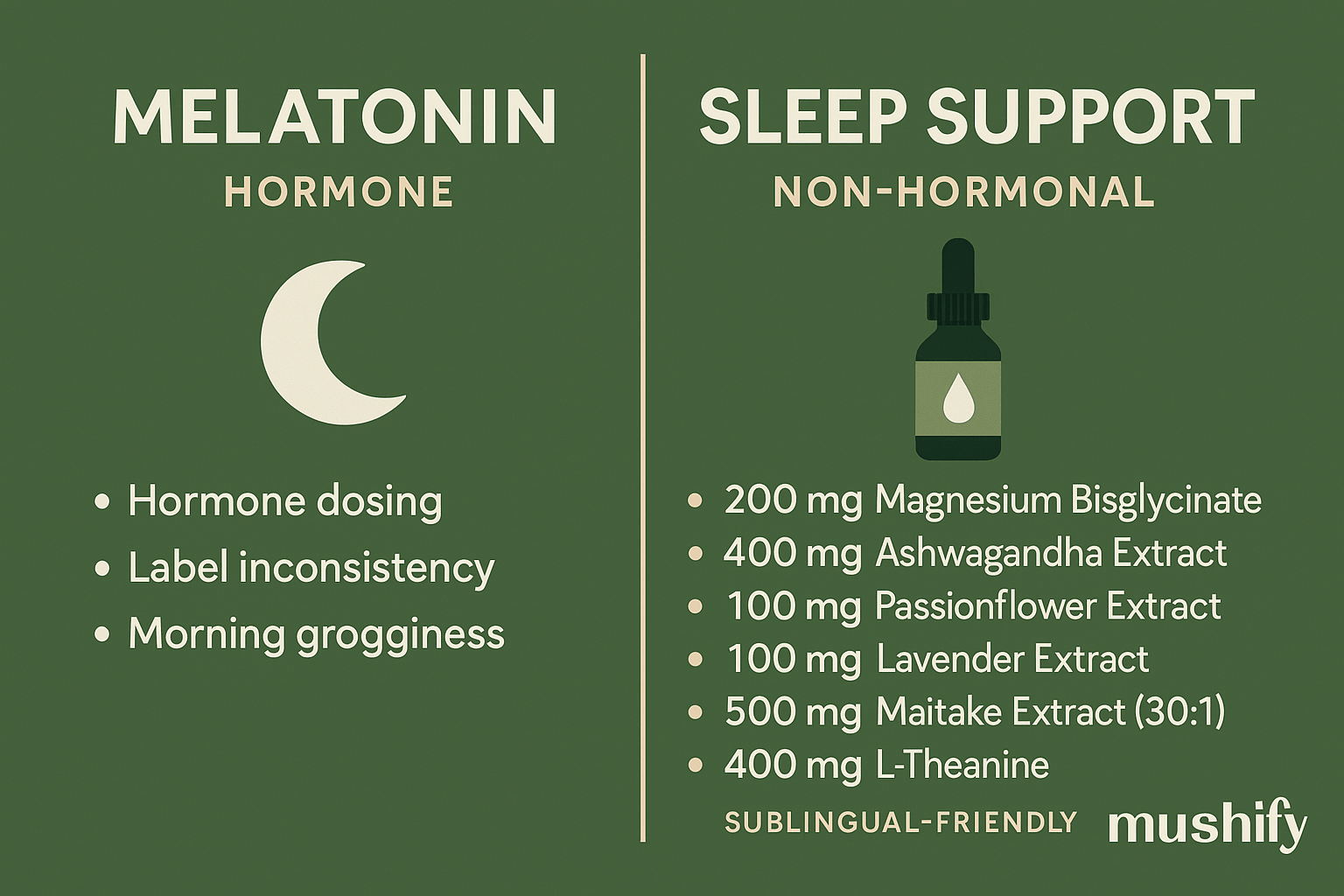Not all “mushroom supplements” are created equal. Many brands sell whole, freeze-dried mushroom powders and imply they’re equivalent to extracts. They’re not. In this article, we’ll unpack:
-
What a mushroom extract is (and why extraction matters)
-
Why freeze-dried powders ≠ extracted actives
-
The practical advantages of liquid extracts (including sublingual use)
-
What a 30:1 extraction ratio means (with simple math)
-
How to choose products that actually deliver functional doses
First principles: what is an extract?
An extract is a concentrated preparation of a plant or fungus where specific bioactive compounds are liberated from the raw material and pulled into a solvent (e.g., hot water for polysaccharides like β-glucans; other solvents for less water-soluble molecules like certain triterpenes). Proper extraction breaks through fungal cell walls (rich in chitin) and concentrates the desired actives into a smaller volume.
-
Hot-water extraction is used to release β-glucans and other polysaccharides that are tightly associated with the fungal cell wall. MDPI+1
-
Certain mushrooms (e.g., reishi) also contain triterpenes that are poorly water-soluble; these are commonly captured via an additional solvent step (a “dual extraction” process). We use a water & glycerin extraction method. MDPI+1
Bottom line: extraction isn’t marketing—it’s chemistry. It’s the difference between “all parts present” and “the parts you actually want, available and concentrated.”
What freeze-drying does—and doesn’t do
Freeze-drying (lyophilisation) is a gentle dehydration method that preserves the raw mushroom for foods and culinary use. It’s excellent for keeping aroma, colour, and many nutrients intact compared with hot-air drying. But freeze-drying does not:
-
Break down chitin in fungal cell walls
-
Liberate or concentrate β-glucans or triterpenes
-
Selectively increase the bioavailable fraction of key actives
So while freeze-dried powders can be good ingredients, they are not equivalent to extracts in terms of accessing and concentrating the compounds you’re paying for. MDPI+2chemistryjournal.in+2
Why extraction matters for bioactives (the short science bit)
-
β-glucans and other polysaccharides sit entangled within chitin-rich cell walls. Hot water helps release and solubilise them so they can be absorbed in the gut. MDPI+1
-
Triterpenes (notably in reishi) are less water-soluble, which is why we use a second extraction step to capture them. Primal Survivor
Think of extraction like pressing olives for extra-virgin olive oil. You can eat whole olives (fine), or you can press and purify the active fraction (better for the outcome you want).
Why Mushify uses liquid extracts
-
Higher concentration per serve
Our extracts are concentrated—you’re not ingesting indigestible cell wall bulk. You’re taking a targeted fraction that’s been liberated and standardised for functional compounds. MDPI -
Flexible dosing + pleasant mouthfeel
Liquids allow precise titration (e.g., 1–2 mL), easy stacking, and seamless integration into routines (coffee, smoothies, water). -
Sublingual option (hold under the tongue)
With liquids, you can hold a serve under the tongue before swallowing. This buccal/sublingual step may speed uptake for small, glycerol-soluble molecules; the larger polysaccharides are absorbed via the gut as usual. It’s a practical advantage powders don’t offer. PharmTech+1 -
Alcohol-free, dual-extracted profile
Our process targets water-soluble (β-glucans) and less-water-soluble fractions (e.g., triterpenes in certain species) while keeping the experience clean and palatable. Primal Survivor
What does 30:1 extraction ratio actually mean?
Short answer: 30 kilograms of raw mushroom go into 1 kilogram of extract.
If a liquid extract is standardised to 30:1, each gram of finished extract represents the actives from ~30 grams of raw material (assuming proper method and yield).
A quick, concrete example
-
Raw material: 30 g of reishi
-
After extraction & concentration: 1 g of reishi extract
-
Takeaway: 1 g of extract ≈ the actives from ~30 g of whole mushroom
Quick comparison
| Feature | Freeze-Dried Powder | Mushify Liquid Extract |
|---|---|---|
| Process | Dehydration only | Extraction + concentration |
| Cell wall/chitin | Intact | Disrupted to release actives |
| β-glucans (water-soluble) | Present, but not liberated | Liberated via hot-water extraction |
| Triterpenes (less water-soluble, e.g., reishi) | Present, but not concentrated | Captured via glycerin extraction |
| Dose efficiency | Bulky servings for effect | Small volumes with high actives |
| Use under tongue | Not practical | Yes (pre-absorptive step for small molecules) |
| Taste/format | Powdery, gritty | Smooth, easy to mix or take neat |
Sources on extraction & cell-wall science: MDPI+2Primal Survivor+2
“But freeze-dried preserves nutrients—doesn’t that make it better?”
Freeze-drying does preserve the raw food matrix excellently for culinary use and storage stability. However, preservation is not the same as liberation or concentration of medicinally relevant actives. For functional supplementation—where you want reliable, efficient delivery of β-glucans and other compounds—extraction wins. MDPI+1
How to spot real extraction quality
-
Named method: hot-water and/or dual extraction
-
Fruiting-body sourcing: clear, transparent sourcing. Aim for something grown naturally, not lab grown on rice
-
Label clarity: extract content per mL (or per serve), not vague “proprietary blends”
The Mushify difference (why our liquids feel different)
-
30:1 concentrated extracts for high actives per mL
- Combined with synergistic tonic herbs for maximum effect
-
Alcohol-free, palatable, and easy to stack across your day
-
Hold under the tongue (then swallow) for a practical, fast-use routine
-
Transparent education you can actually understand
Takeaway
If you want food-like mushrooms for cooking, freeze-dried powders are fine.
If you want a functional supplement that delivers liberated and concentrated actives in small, precise doses, proper extracts are the smarter choice.
Mushify liquid extracts = less bulk, more bioavailable actives, and a cleaner daily experience.
References (selected)
-
Arruñada, L. et al. (2024). Chemical structure characterization of edible mushroom-extracted β-glucans. Carbohydrate Polymer Technologies and Applications. (overview of extraction variables influencing β-glucan yield). ScienceDirect
-
Sun, L. et al. (2023). The glucans of mushrooms: molecules of significant biological and industrial value. Journal of Fungi, 9(3): 316. (β-glucan significance and properties). MDPI
-
Liu, L. et al. (2021). Comparison of fungal vs plant cell wall behaviour during digestion. Trends in Food Science & Technology. (cell-wall structure impacts digestibility and bioaccessibility). ScienceDirect
-
Foods (2024). Impact of Dehydration Techniques on Dried Mushrooms—review. (freeze-drying preserves raw matrices but is not extraction). MDPI
-
Pharmaceutical Technology (2014). Considerations in developing sublingual tablets. (mechanisms and considerations for sublingual uptake—relevant to liquids’ pre-absorptive use for small molecules). PharmTech


